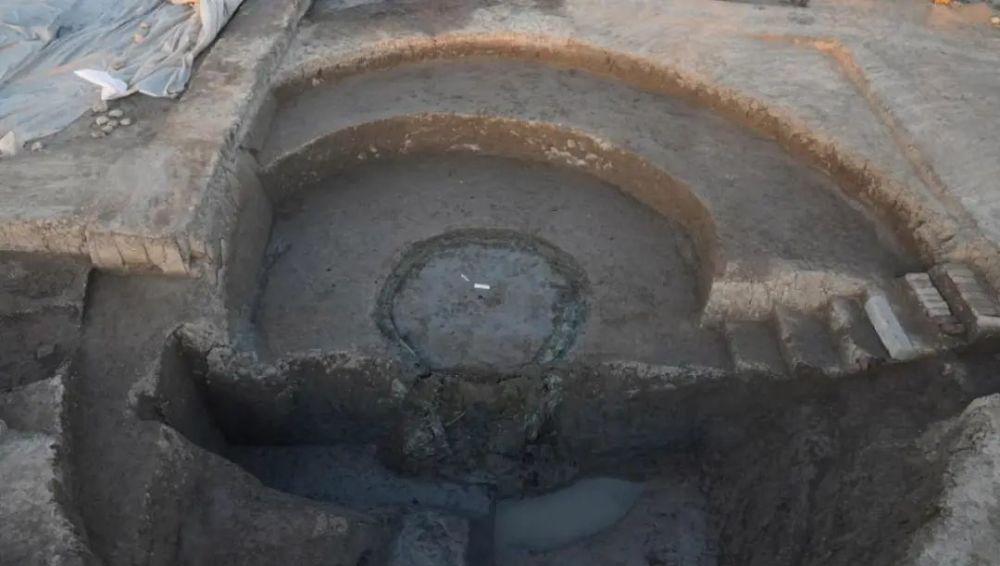Tianjin, on the shore of the Bohai Sea and the land of retreating from the sea, provides a favorable time and place for the development of the salt industry. In 925 AD, the Later Tang Dynasty Youzhou Festival made Zhao Dejun set up a field in this land of lush reeds, which was named after the place name, and the history was called "Lutai Field". The excavation results of the ruins of Tianjin Junliang City announced today confirm the true existence of this period of history.

Panoramic view of the brine well (J1).
The reporter learned from the Tianjin Municipal Cultural Heritage Protection Center today that since April this year, the archaeological staff of the center has carried out archaeological excavation work in the demonstration town of Junliangcheng in Dongli District, Tianjin, completed the excavation area of 8,000 square meters, found a large rammed earth platform foundation of the Tang Dynasty and the Tang Dynasty salt workshop area, cleared out more than 200 relics such as ash pits, ash ditches, stoves, wells, kilns, and ruts, unearthed a large number of Specimens of Tang Dynasty artifacts with obvious characteristics of the times, and also unearthed a small amount of copper coins (mainly Kaiyuan Tongbao), copper armor pieces, Specimens such as animal bones. More than 20 ash pits, ash ditches, stoves and house foundation sites in the Yuan, Ming and Qing dynasties were found, and a large number of clay pots, blue and white porcelain bowls, blue glazed bowls, white glazed bowls, pottery lamps and other raw words and building components such as bricks and tiles were unearthed.
Photo of the excavation of the brine well (J2).
Gan Caichao, the person in charge of the project, introduced that in the third excavation area of the ruins of the Military Grain City, the ruins of brine wells, ash pits, salt stoves, beach yards, ash ditches and other relics were found, which should be directly related to the salt making processes such as taking brine, brine making, frying brine and drying, and there are dozens of other related relics, which together constitute a relatively complete Tang Dynasty salt workshop area. This is the first time that Tianjin archaeology has found the remains of ancient salt production, filling the archaeological gap of Tianjin salt industry.
Ash ditches, ash pits, stove sites, ruts
According to reports, this excavation is the first time in nearly 70 years in the Tianjin area that such a large area and the main body is piled up as a Tang Dynasty site. In all trenches within 60,000 square meters of the fourth excavation area and 0.9 million square meters in the third excavation area, rammed earth platform foundations of about 1 meter high were found, and the rammed surfaces of the rammed layer were relatively flat and clear, and the two platform foundations were distributed in an east-west direction, with a distance of about 450 meters. Among them, the rammed earth terraces in the fourth excavation area are about square, and the remaining length is about 255 meters from north to south and about 240 meters from east to west, and the current surface of the southeast is partially preserved, and the rammed earth terraces are superimposed under the accumulation of the Ming, Qing, Yuan and Tang strata, and the surface of other areas has been destroyed by late activities, and only part of the rammed earth platform remains.
Special relics are cleaned up and extracted
The accumulation of the Ming and Qing strata is about 1.5 meters thick, and the relics are found to be relatively rich; the accumulation of the Yuan Dynasty strata is about 0.3 meters, no relics have been found, and there are fewer excavated relics; the tang Dynasty strata are about 0.3-0.5 meters thick, and nearly 10 relics such as ash pits, ash ditches and wells have been found, and typical Tang Dynasty relics such as white glazed porcelain bowls, small square bricks, grooved bricks, and lotus pattern tiles have been unearthed. Combined with the Tang Dynasty tombs of Baishaling, Liu Taipei, Southwest Homage, Tangwa, Liutai Middle School and Foreign Trade Warehouse discovered by Tianjin Archaeology in the junliangcheng area since the 1950s to the 1980s, these sites and tombs are centered on the large rammed earth platform foundations discovered by this archaeology and distributed around them, which together constitute a large settlement system with higher tang dynasty rank in the southern region of Tianjin.
Unearthed Tang Dynasty porcelain bowl
This discovery provides a possibility for exploring the Tang Dynasty Haikou in the Tianjin area. The central position and building volume of the large-scale Tang Dynasty rammed earth platform planning site of the military grain city fully reflect the systematic and ultra-large-scale artificial construction activities carried out due to special needs under the management of the tang dynasty's extremely strong political (or military) organization. According to archaeological findings, the area where the ruins of Junliang City are located is the best choice for discussing the Tang Dynasty "Sanhui Haikou" recorded in the literature, which is of great significance for the transformation of Tianjin's ancient port and the study of the relationship between ancient people and land in Tianjin.
(Guangming Daily all-media reporter Liu Qian, Chen Jianqiang)
Hot video recommendations
Source: Guangming Daily all-media reporter Liu Qian Chen Jianqiang
Photo: Tianjin Cultural Heritage Protection Center
Editor-in-charge: Wang Zimo
Editor: Zhu Xiaofan, Chang Ying